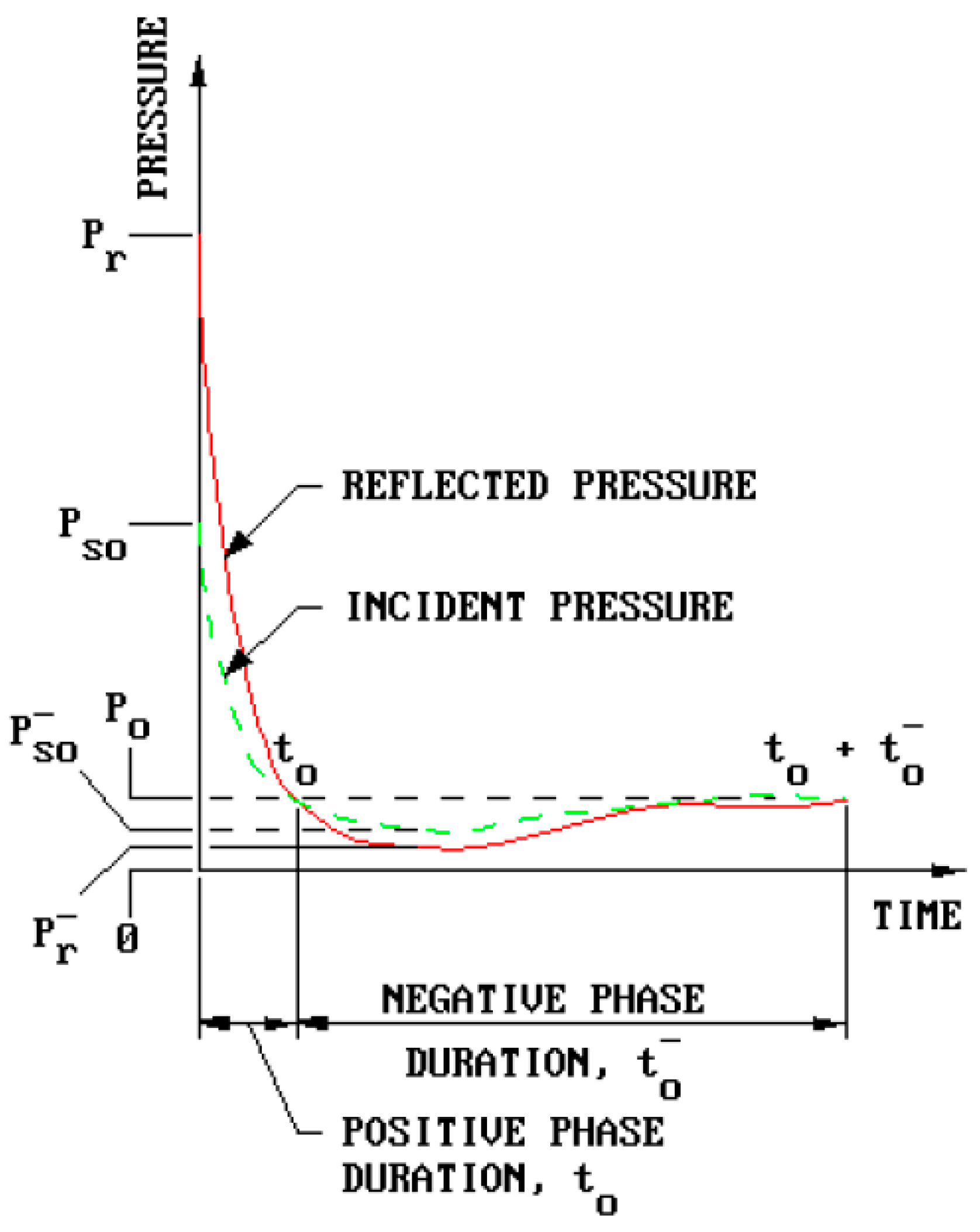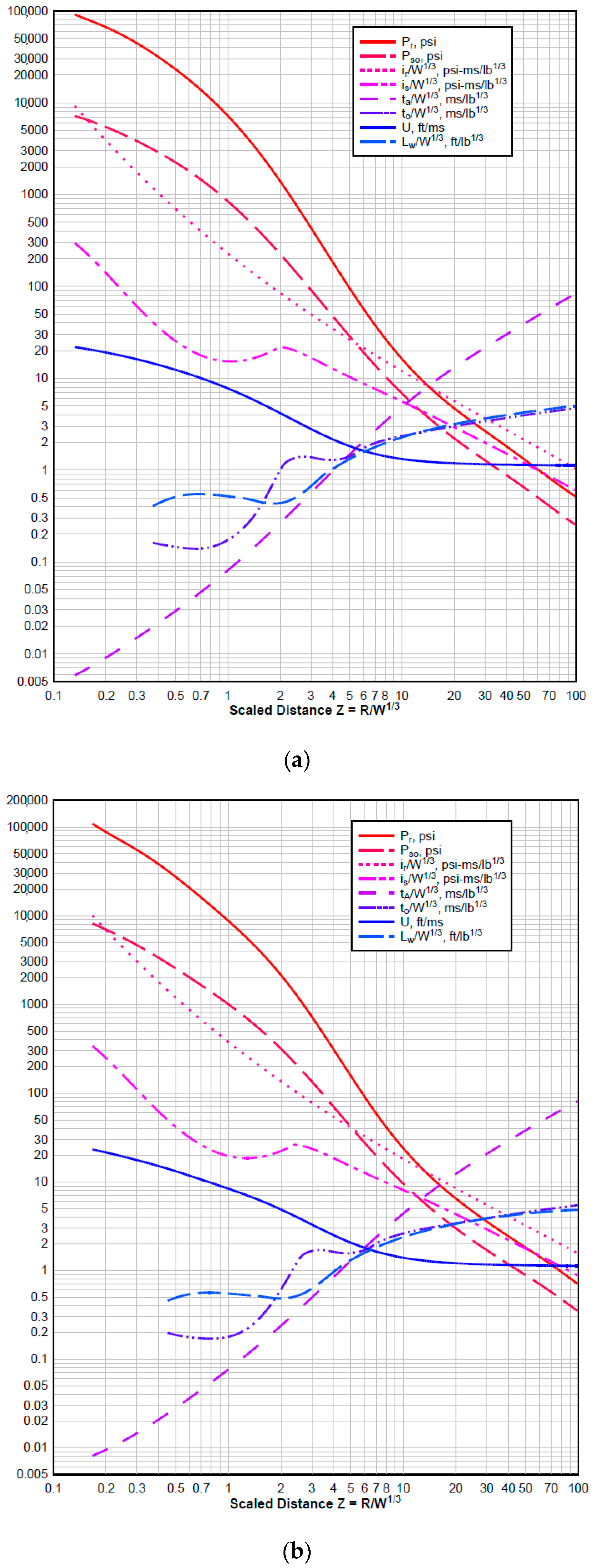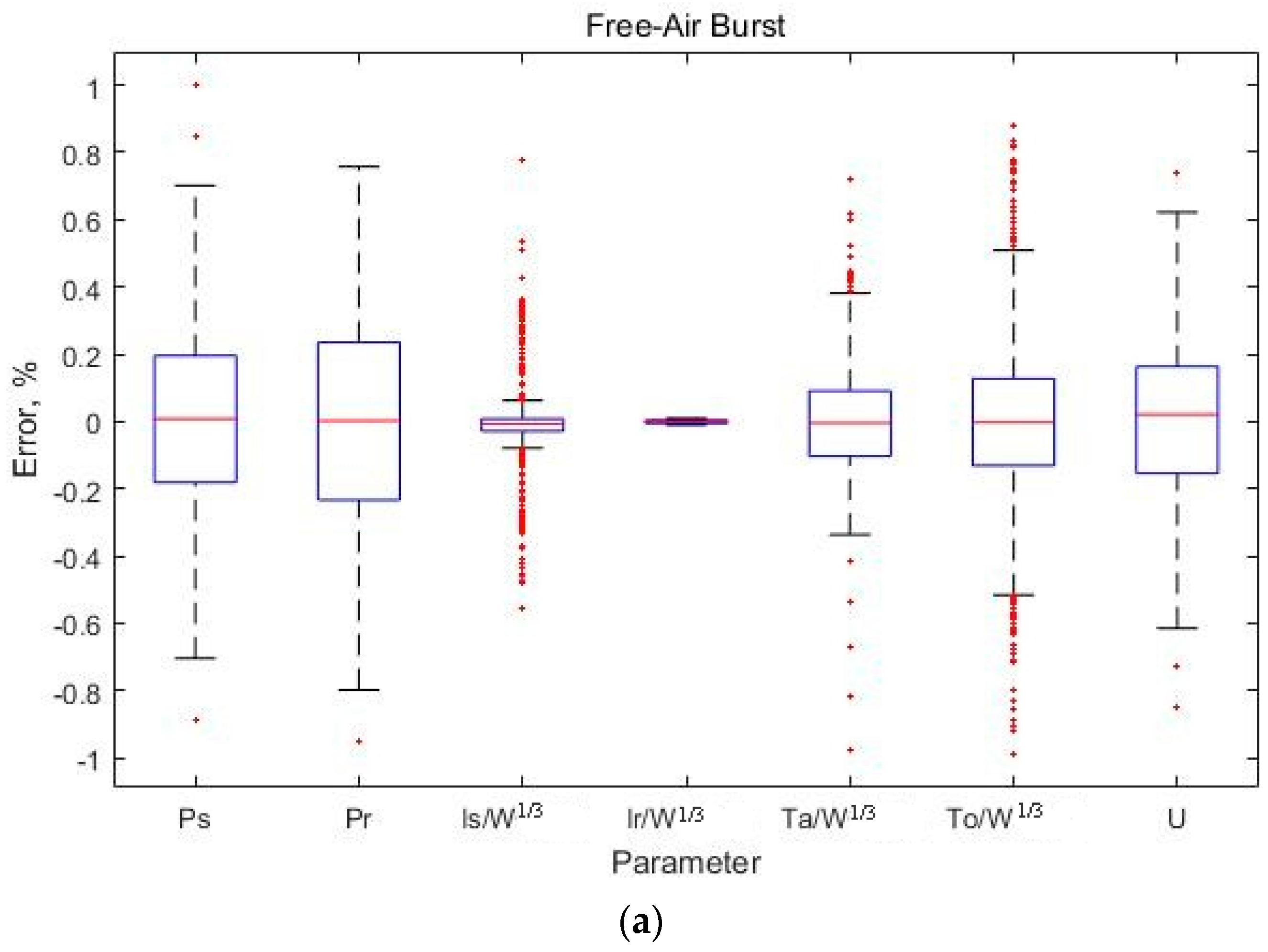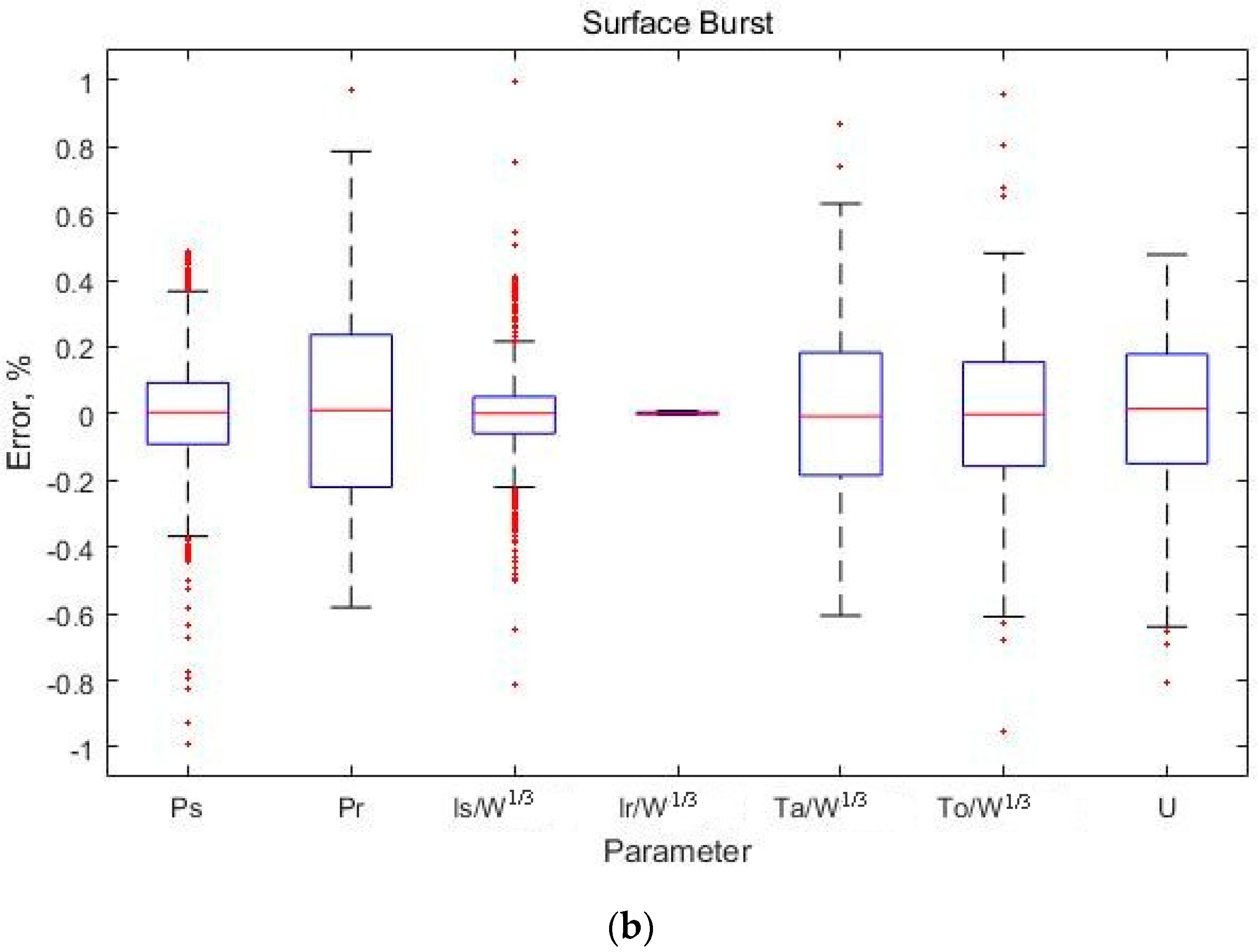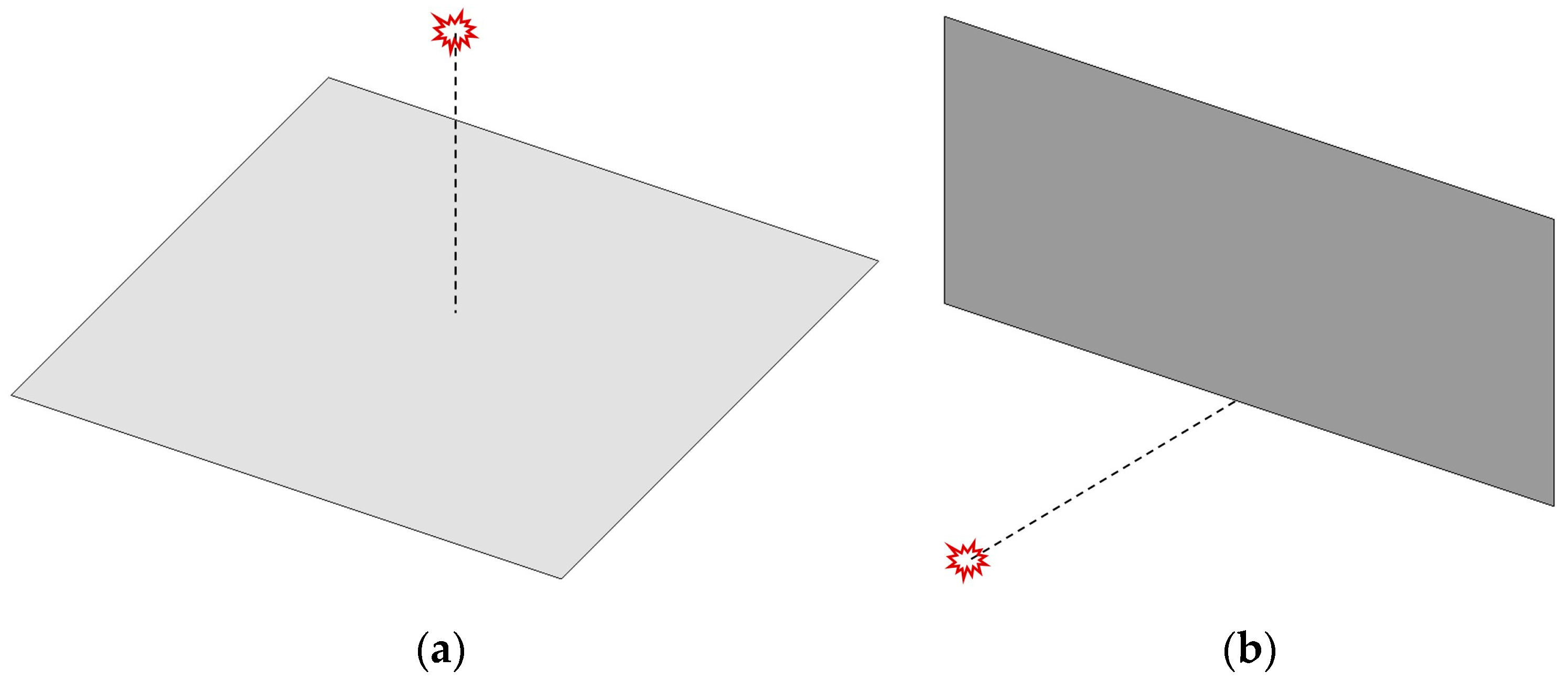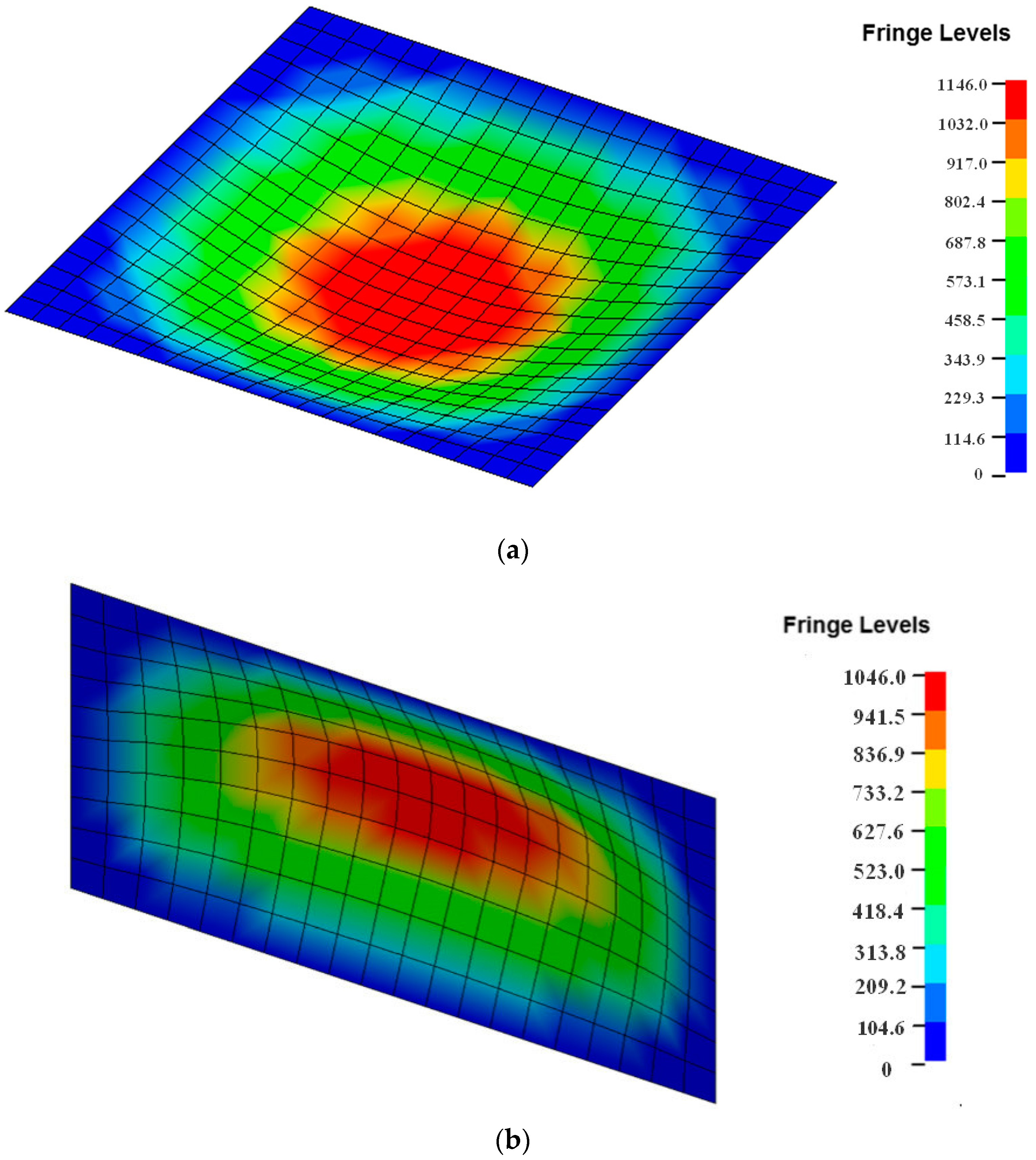1. Introduction
Owing to the increasing damage to structures and human life due to blasts, such as terrorist attacks and gas explosion accidents, social concerns regarding abnormal loads, such as impacts and bursts, is increasing. Accordingly, many studies have assessed the effects of abnormal loads worldwide [
1,
2,
3]. In addition, the need for blast resistance design is increasing due to recent international terrorist attacks and their threat.
The blast load can be estimated using a blast load equation and numerical analysis. The former method employs an equation established based on the experimental data of various bursts [
4]. The method using a blast load equation allows the easy and rapid calculation of a blast load, but it is applicable only to cases where a blast wave strikes an object directly. The latter method is used to analyze the behavior of a fluid after a burst and estimates the resulting pressure [
5]. This method is applicable to various cases using a range of numerical analysis models, but requires a long time for the load calculation. The most extensively used numerical analysis method employs a blast load equation; these equations are used for explosion-proof design of structures and exterior materials [
6,
7,
8].
Many studies have been conducted to establish blast load equations in the past. Because blast loading is challenging to deal with by a theoretical approach, empirical formulae based on experimental data have been suggested [
9,
10,
11,
12,
13,
14]. The Kingery-Bulmash equation, which is the most widely used equation, has been applied to UFC 3-340-02 [
15], a manual published by the U.S. Department of Defense, and Conwep [
16], a blast load estimation software developed by the U.S. Army Corps of Engineers. On the other hand, the Kingery-Bulmash equation includes complicated calculation processes, which makes a direct calculation of a blast load difficult. Swisdak proposed a simplified Kingery-Bulmash equation [
17], but the application of the equation was limited to a surface burst. This paper briefly introduces the characteristics of blast loading and various equations for a blast load estimation, and proposes a modified equation.
2. Characteristics of Blast Load
Bursts can be classified as free-air bursts, and surface bursts according to the position of detonation. A free-air burst refers to a burst in the air at a position far away from the ground surface, as shown in
Figure 1a. In the case of a free-air burst, the shock wave generated from the center of the burst position is propagated spherically and strikes a structure directly without amplification in the process of propagation. A surface burst refers to a burst that occurs on the ground surface, as shown in
Figure 1b. In this case, the shock wave is amplified from the burst position by reflection on the ground surface [
15].
A shock wave generated by a burst applies air pressure to a structure, and the load by the pressure may be represented by a pressure-time history curve, as shown in
Figure 2.
The maximum pressure is found instantaneously at the moment when the shock wave reaches an object, and then the pressure is decreased rapidly (positive pressure phase). A negative pressure that is lower than atmospheric pressure is generated and then converges gradually to atmospheric pressure (negative pressure phase). On the other hand, only the positive pressure phase is considered in most burst analyses because the effect of the negative pressure phase is negligible compared to the positive pressure phase.
As shown in
Figure 2, a pressure-time history curve of a blast load may be represented by several parameters. The following parameters were used to estimate the blast load:
: Maximum incident blast overpressure;
: Maximum reflected blast overpressure;
: Impulse by the incident blast overpressure;
: Impulse by the reflected blast overpressure;
: Arrival time of the shock wave;
: Duration of the positive pressure phase;
: Velocity of the shock wave at arrival.
The UFC 3-340-02 provides diagrams of these parameters depending on the scaled distance for a free-air burst and a surface burst (
Figure 3) [
15].
3. Equations of a Blast Load
Various equations for estimating the blast loads have been suggested. These equations, which have various forms, are empirical equations built on experimental data, because the blast loads are difficult to deal with through a theoretical approach, such as the Sadovsky equation, the Brode equation, the Kingery-Bulmash equation, etc. [
9,
10,
11,
12,
13,
14]. Most equations commonly employ a scaled distance as a parameter, which is calculated using Equation (1):
where,
: Scaled distance;
: Distance to the burst position;
: TNT weight.
Kingery and Bulmash provided equations for calculating all the parameters together for a free-air burst or a surface burst in addition to the maximum incident blast overpressure, as shown in Equations (2a) and (2b) [
14]:
where,
: Shock wave parameters (
,
,
,
,
,
,
);
: Constants.
The Kingery-Bulmash equation enables calculations of the free-air burst parameters in a scaled distance range of 0.05 to 40
(0.132 to 100
) and the surface burst parameters in a scaled distance range of 0.06 to 40
(0.167 to 100
). The constants,
K and
C, are dependent on the type of burst, the range of scaled distance, and the parameters to be calculated. The number of the constant
K is 2, while that of the constant
C ranges from 4 to 15. For example,
Table 1 lists the constants
K and
C used to calculate the maximum incident overpressure in a free-air burst.
In addition, the simplified Kingery equation for an air-blast calculation suggested by Swisdak (hereinafter called Swisdak equation) is expressed in Equation (3) [
17]:
This Swisdak equation, which built on the Kingery-Bulmash equation, includes two to seven constants. The error rate of the equation compared to the conventional equation is less than 1%, indicating that the Swisdak equation is considerably accurate. On the other hand, this equation is applicable only to a surface burst, and the range of scaled distances that can be calculated using this equation does not incorporate the range of conventional equations. For example,
Table 2 lists the constants used to calculate the maximum incident overpressure.
4. Modified Equation of the Blast Load
As described above, the Kingery-Bulmash equation is applicable to both a free-air burst and a surface burst and enables calculations of all the parameters of the pressure-time history curve of a blast load. In addition, this equation is the most widely used as it has been applied to UFC 3-340-02, a manual published by the U.S. Department of Defense, and Conwep, blast load estimation software developed by the U.S. Army Corps of Engineers (commercial software programs used frequently for explosion analysis, including Abaqus [
19], Autodyn [
20], and LS-Dyna [
21], are equipped with the Conwep model for a blast load estimation). On the other hand, the equation has a long calculation process including three stages. In addition, it is complicated and requires many constants for calculations. Therefore, the present article proposes a modified equation based on the Kingery-Bulmash equation.
The following conditions were established for the modified equation:
The modified equation should be based on the Kingery-Bulmash equation.
The modified equation should incorporate the entire range of scaled distances provided in the conventional equation. (The range of scaled distances is 0.05 to 40 for a free-air burst and 0.06 to 40 for a surface burst).
The calculation of the variable, U, included in the conventional equation should be omitted.
The basic form of the function should be an exponential function, and the exponent should be expressed as a polynomial using the common logarithm of scaled distance () as a variable.
The number of constants used for the modified equation should be less than or equal to five, and the constants should have five significant figures.
The error rate with the conventional equation should be less than or equal to 1% over the entire range of scaled distance.
According to the conditions described above, the calculation process of the modified equation was established as follows:
Step 1. Calculate the scaled distance, Z
Step 2. Calculate the parameters
The curve fitting algorithm based on the values of the original equation was used to determine the constant,
C, of the modified equation. The curve fitting algorithm was used by Levenberg-Marquardt, and it enables relatively stable and rapid convergence to the solution [
22,
23]. This method, which is a representative method of solving a nonlinear least square problem, combines the Gauss-Newton method and the gradient descent method.
Table 3 and
Table 4 present the constant,
C, determined by curve fitting for a free-air burst and a surface burst, respectively.
To compare the modified equation proposed in the present article and the conventional Kingery-Bulmash equation, the error between the two equations was calculated at 500 points with respect to the entire range of scaled distances (
Table 5 and
Table 6). The results showed that the maximum error rate is less than or equal to 1% and the mean error rate is less than or equal to 0.3%, indicating that the modified equation proposed in the present article is consistent with the conventional equation (
Figure 4).
5. Verification of the Modified Equation
In order to verify the modified equation, two types of simple plate models with properties as shown in
Table 7 were set up, and the residual displacements were compared by applying the Kingery-Bulmash equation and the modified equation.
The location of the explosion is shown in
Figure 5; both the free-air burst and the surface burst are located 5 m from the surface of the plate. The thickness (
) of the plate was set differently for each blast load case to compare the residual displacements after plastic deformation.
Table 8 presents the conditions of the blast load.
The simulations were conducted by LS-Dyna, which is a typical commercial software used for blast analysis (
Figure 6). After the analysis, the residual displacements were measured at a point every 1 m from the center of the model for free-air burst simulations, and from a height of 0.5 m above the bottom of the plate for surface burst simulations.
Table 9 and
Table 10 show the simulation results by two equations. They show that the results of the modified equation are very similar to those of the Kingery-Bulmash equation.
6. Conclusions
Among the various blast load equations, the Kingery-Bulmash equation is applicable to both a free-air burst and a surface burst and enables calculations of the parameters of a pressure-time history curve. In addition, this equation is the most widely used equation and is applied to the UFC 3-340-02 and the Conwep model. On the other hand, the calculation using the Kingery-Bulmash equation is complicated. To simplify the process, Swisdak proposed a simplified version of the equation but the Swisdak equation is applicable only to a surface burst. Moreover, the range of scaled distances that may be calculated by using the Swisdak equation does not incorporate the range of conventional equation. To solve these problems, the present article proposes a modified equation.
The modified equation proposed in this article is applicable to both types of bursts, as is the case of the Kingery-Bulmash equation. In addition, the range of scaled distance that may be calculated using the modified equation is the same as that of the original equation. The modified equation proposed in the present article has a shorter calculation process because the unnecessary calculation procedures included in the conventional equation are omitted. Moreover, the number of constants has been reduced to five or less to make the equation simpler. The error rate of the calculation was less than 1% compared to the results calculated from the conventional Kingery-Bulmash equation. Two types of plate models were simulated by applying the Kingery-Bulmash equation and the modified equation. As a result, the modified equation has a very similar effect to the Kingery-Bulmash equation.
On the other hand, the modified equation has two limitations. First, the derivation of the modified equation does not have sufficient theoretical background; this problem is shared by other empirical equations built on experimental data. Second, the data used to establish the modified equation are not experimental data but the values calculated using the conventional Kingery-Bulmash equation. The use of actual experimental data would be better for establishing an equation, but there is insufficient experimental data available. Because the purpose of the present study was not to derive a new equation but rather to develop an equation for simpler calculations that produce similar results to those of the Kingery-Bulmash equation, the calculation results obtained using the conventional equation may be used.
Therefore, the modified equation proposed in this article, which can provide the same calculation results through a simpler calculation process, may supplement or even replace the Kingery-Bulmash equation if used for appropriate situations with an understanding of the limitations described above.

